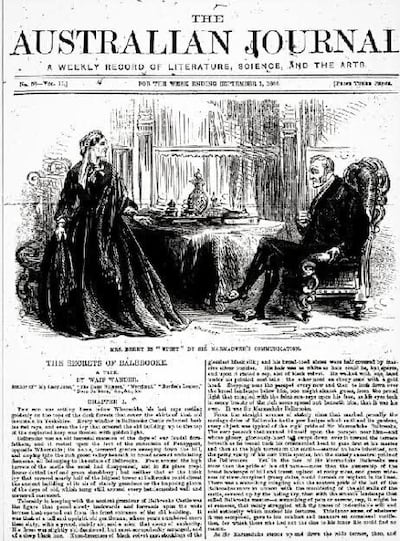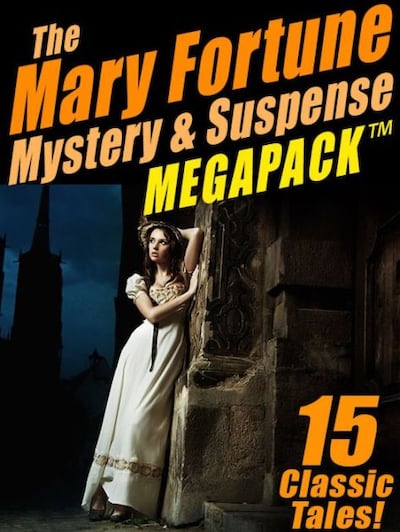In 1911 a woman named Mary Helena Fortune died in Melbourne, Australia, her death largely unremarked. By then she was an alcoholic, nearly blind and boasted a career criminal for a surviving son, the exotically named Eastbourne Vaudrey Fortune – better known, unsurprisingly, as George. She subsisted on a small pension from the Australian Journal, and was so poor when she died that she was buried in a grave intended for another.
Only in the 1950s was Fortune connected to the pseudonym WW, or “Waif Wander”, under which she wrote hundreds of crime stories, including a pioneering series for the Journal called The Detective’s Album, detailing the cases of an Australian lawman named Mark Sinclair. So convincingly did Fortune inhabit these first-person accounts that readers were convinced they were the work of a serving or recently retired officer of the law. The Journal did nothing to disabuse its subscribers of this notion, probably figuring the myth would sell more copies than the truth, which was that the tales were being written by a clever, gifted woman born in Belfast in 1833, one who had arrived in Australia via Canada in 1855 with her father and infant son, leaving a bad marriage behind her.

Fortune rarely figures in lists of Irish authors, partly due to confusion over her roots, but also because she was a genre writer – doubly-cursed, as we shall see, by being a woman – and Ireland does not have an unblemished record when it comes to recognising the contribution of genre practitioners to its literature, markedly so in the last century. The general exception is the Gothic, which is difficult to ignore, although the fact that it can be read politically makes it more palatable to genre sceptics.
The assault on genre writing in Ireland began as early as 1892, when Douglas Hyde, eventually to become the first president of the Irish Free State, gave a speech to the Irish National Literary Society in Dublin in which he urged his listeners to set their faces “sternly against penny dreadfuls, shilling shockers”. To Hyde, genre writing was not only “garbage” and “vulgar”, it was also “English”, which made it undesirable in the extreme. It had no relevance to his conception of Irishness, which was limited to everything “most smacking of the soil, most Gaelic”. If it was genre fiction, it wasn’t Irish literature. In fact, it probably wasn’t literature at all.
Low culture
One of the fallacies still occasionally peddled about Irish genre fiction is that it exists separately from some more elevated form of writing, but that is as untrue of Irish literature as it is of literature in general. For much of its history, all fiction was regarded as low culture, regardless of content. Its greatest sin was its accessibility: to appreciate fiction didn’t require one to be learned, only to possess a little learning.
To most 18th- or 19th-century readers, looking down one’s nose at a work of fiction because it contained genre elements would have seemed as absurd as relegating Hamlet and Macbeth to second-division Shakespeare because they happened to contain ghosts. A hierarchy in which genre fiction must, of necessity, sit below literary fiction is largely a product of 20th-century critical thinking. Until then there are, to paraphrase Duke Ellington on music, just two kinds of fiction: good fiction, and the other kind.

Neither is there a clear line separating Irish literary and genre writers. Douglas Hyde’s fellow Celtic Revivalist WB Yeats, whose fascination with the occult extended to the anthologising and creation of ghost stories, prized authors who were willing to explore the limits of their imagination. In 1912 he used the Cuala Press to publish the work of Lord Dunsany, one of the fathers of what is now termed “weird fiction”; Dunsany would, in turn, encourage the young Mary Lavin in her writing. Elizabeth Bowen penned forewords to two books by Joseph Sheridan Le Fanu, and contributed stories and an introduction to the Ghost Books edited by Lady Cynthia Asquith. When asked by the New Yorker in 1992 to list his literary influences, William Trevor, who aspired to write thrillers when young, could point only to the detective novels he had read as a child. Brian Moore started out as a thriller novelist, and worked with Alfred Hitchcock. Liam O’Flaherty published stories in Ellery Queen’s Mystery Magazine. The list of these Irish literary cross-pollinators goes on and on.
Holy trinity
Nearly 40 years after Hyde first rallied the troops against genre fiction, the Corkonian writer and academic Daniel Corkery, representing the extreme nativist rump of the Irish critical camp, would define the three great forces of the Irish national being – and, by extension, its literature – as the Religious Consciousness of the People, Irish Nationalism, and The Land. Anything else, quite frankly, could go and hang. Corkery might have added one further proviso: masculinity, because the narrative of Irish fiction was, for much of the 20th century, predominantly male.
In 1964 Vivian Mercier edited a collection, Great Irish Short Stories, with selections dating from AD 700 to the modern, but found space for only three tales by female writers. Mercier's aim, according to his introduction, was "to show that Irishmen [my italics] do have a special gift for the short story". The situation had improved somewhat by the end of the century, but only because it could hardly have got much worse. Barely a quarter of the pieces in the mammoth Penguin Book of Irish Fiction (1999), which began its overview in 1726 with Gulliver's Travels by Jonathan Swift, were the work of women, a proportion corresponding almost precisely to the level of female representation among writers of fiction in 1950, historically the lowest ebb for women's involvement in its production.
Both volumes, it’s worth noting, display a marked aversion to genre literature, the obligatory Gothic aside, an absence that inadvertently perpetuates old injustices, because to exclude genre writing is also automatically to exclude a great deal of fiction by women, who were especially attuned to the commercial and artistic possibilities of genre work. This is a manifestation of what has been termed the “masculinity of high modernism”, which distrusted popular literature and placed a premium on literary experimentation and the idea of the novel as high culture, particularly when written by a man.
Not that female critics have been united in their view of genre writing. In her 1985 essay Irish Women and Writing in Modern Ireland, Nuala O’Faolain asked “Why have so few Irish women been writers at all?” – a question arguably based on a false premise, as the contents of Shadow Voices show – before proceeding to reject genre fiction as an appropriate form of literature for women, arguing that “realism is the only mode available to women writers who want to write to and of women”. According to O’Faolain, it was economic reasons alone “which have, in modern times, driven the woman writer towards popular genres”.
Police misogyny
Aside from taking a fairly doctrinaire approach to the perfectly understandable desire of writers to earn a living from their work, O’Faolain perhaps underestimated the seriousness, artistry and ingenuity of generations of female genre authors. The popular Irish Victorian writer and editor LT Meade, who used her influence to promote education and employment for women (and, probably not unconnectedly, was a favourite target of male critics), examined issues of matrimonial finance and female entrepreneurship in her stories, but with a feather-light touch. More recently, Jane Casey’s depictions of a first-generation Irish woman, Maeve Kerrigan, negotiating misogyny and sexism in London’s Metropolitan Police seem horribly prescient in light of the rape and murder of Sarah Everard by PC Wayne Couzens earlier this year.
Economic imperatives may play a part in a writer’s choices, but genre authors have long recognised that their stories can function as stealth carriers for ideas and social commentary, operating much more subtly and effectively than pamphlets and polemics.
Excising genre writing from the narrative of Irish literature also drains it of much of its joy and colour. Beatrice Grimshaw’s 1922 story The Cave is unashamed pulp, a story of sailors being hunted by a spectral dinosaur on a remote island, but it’s also delightful for being so far removed from one’s conception of what fiction written by a daughter of textile manufacturers from Co Antrim might resemble. Grimshaw was liberated by the acquisition of a bicycle as a young woman. Having experienced the joys of independently exploring the Antrim hinterland, she realised there was nothing to stop her from venturing farther afield, and ended up spending 30 years living and working in New Guinea. Again, you will search in vain for her in most anthologies of Irish writing, those of fine specialised publishers such as Dublin’s Swan River Press aside.
So Shadow Voices is not an alternative interpretation of Irish literary history. Rather, it takes more than 60 Irish authors, many of whom have been ignored, forgotten or expunged from the standard version, and restores their life and work to that larger record. Those two words – life and work – are important here. To dismiss so much of this writing as “blank” and “nothing”, as one major Irish novelist and critic has latterly done, is also to dismiss the lives of its creators as essentially valueless. For writers such as LT Meade and Mary Helena Fortune, their lives were their work, and as women they had to overcome significant obstacles to make their mark. They deserve better than to be reduced to an inaccurate footnote in a prohibitive chronicling of Irish fiction. Shadow Voices is, I hope, one more step towards redressing that injustice.
Shadow Voices: 300 Years of Irish Genre Fiction, A History in Stories, edited by John Connolly, will be published in a signed edition by Hodder & Stoughton on October 28th



















